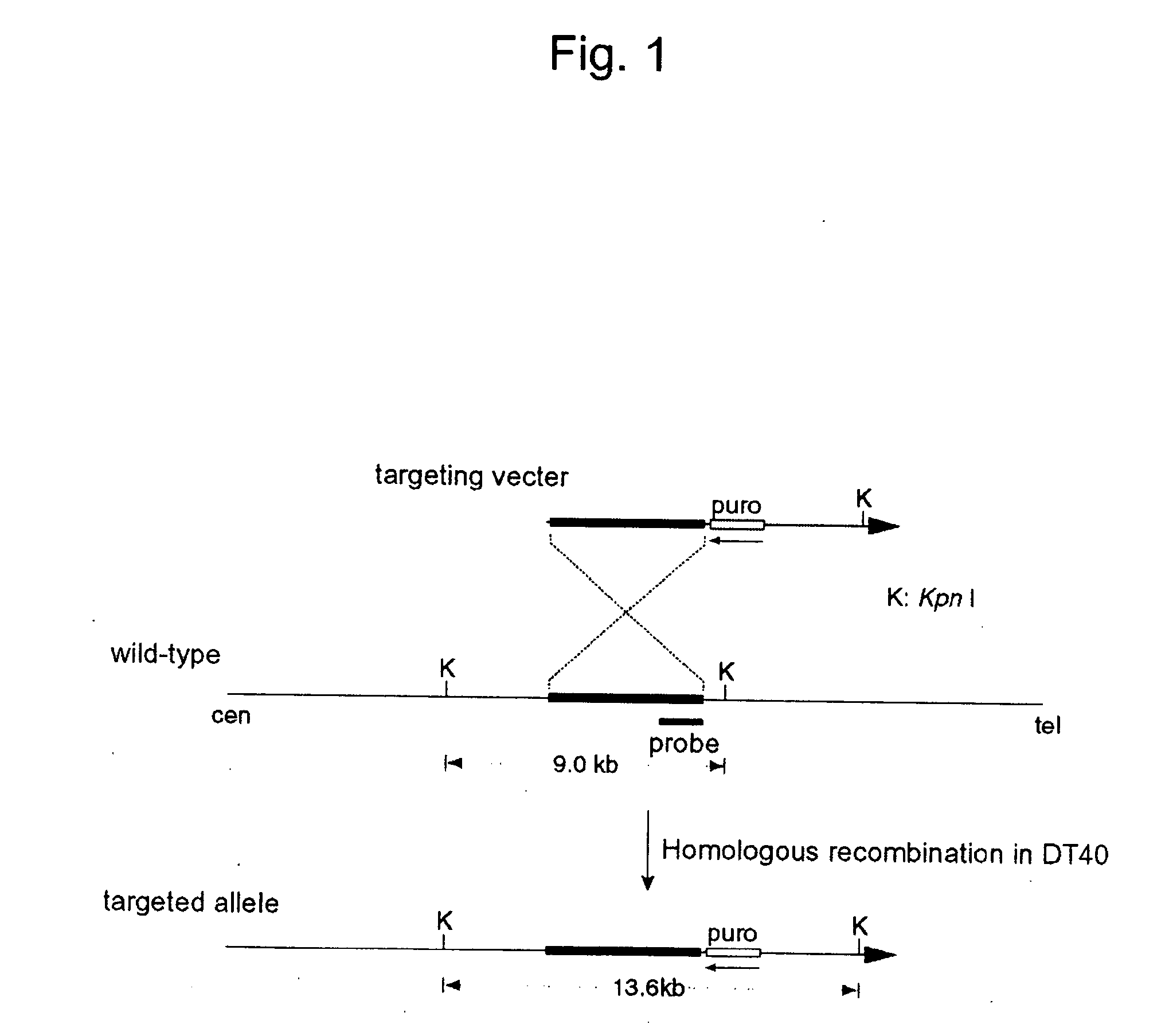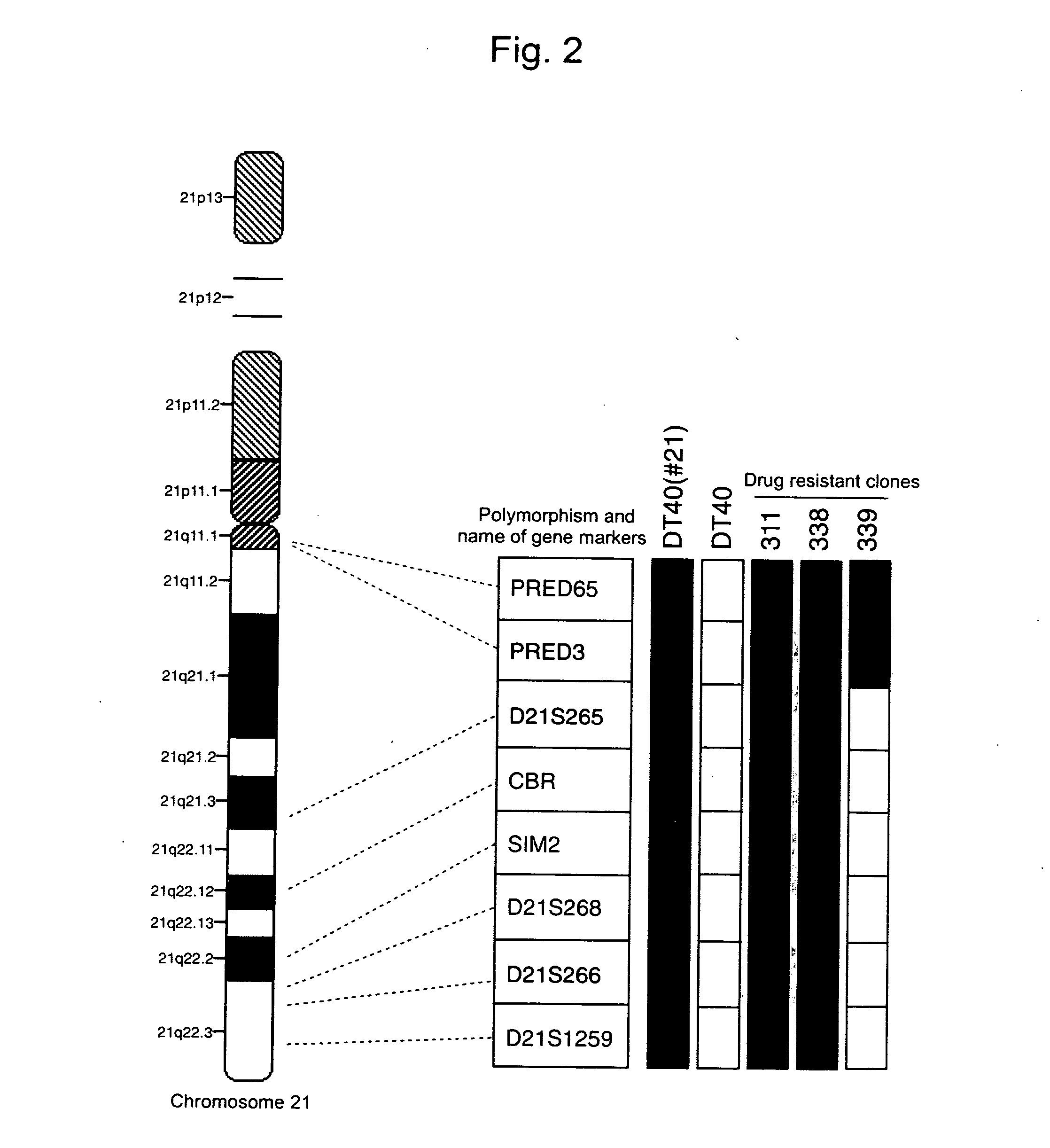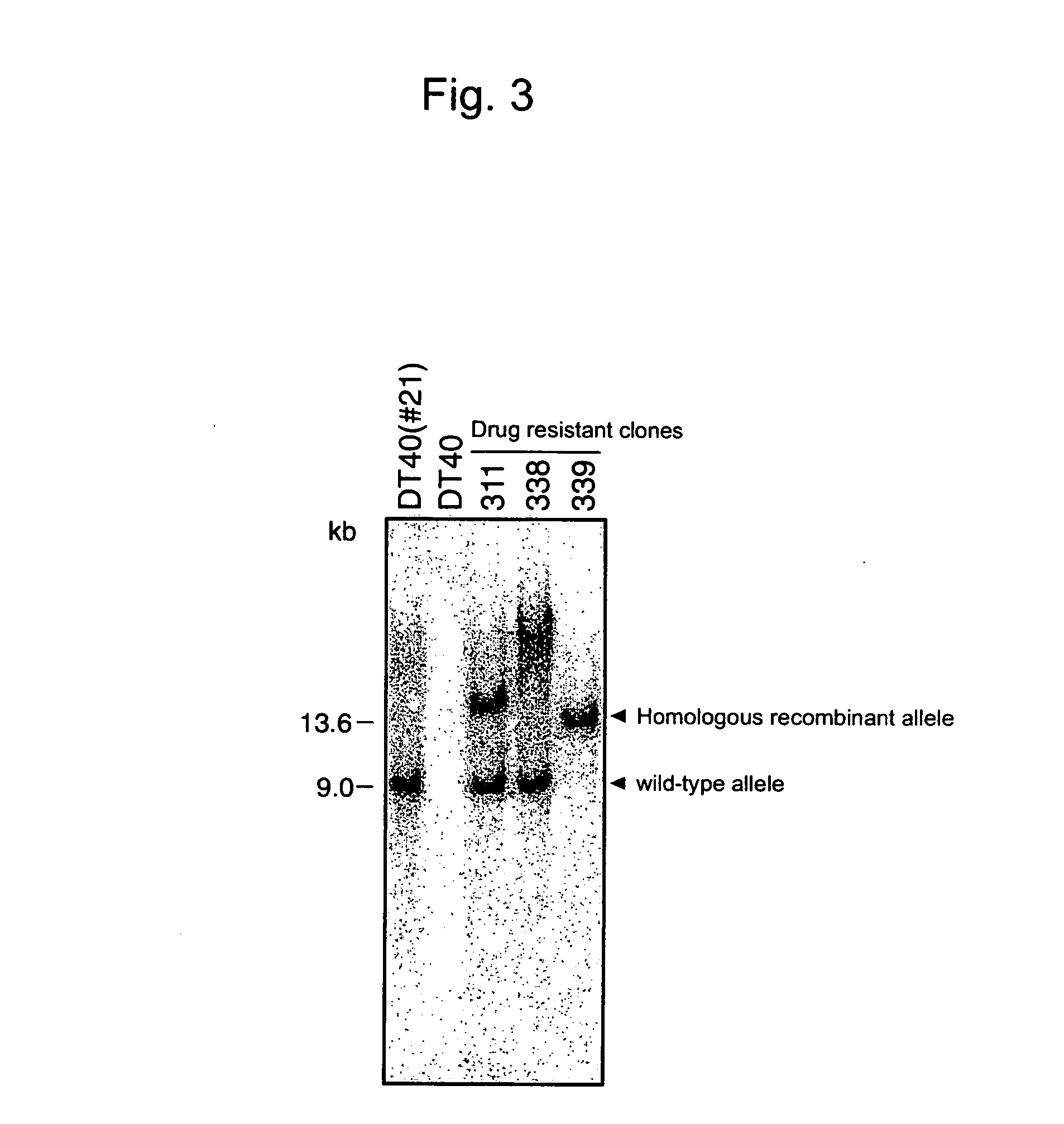Human artificial chromosome (hac) vector
a human and artificial chromosome technology, applied in the field of human artificial chromosomes (hac), can solve the problems of not being able to realistically modify the chromosome for every target gene, not being able to control the insertion of foreign dna, and not being able to make clear the structure, etc., and achieve the effect of stably retaining cells
- Summary
- Abstract
- Description
- Claims
- Application Information
AI Technical Summary
Benefits of technology
Problems solved by technology
Method used
Image
Examples
example 1
Preparation of HAC Vector by Deleting Distal Region of the Long-Arm of Human Chromosome 21
(1) Construction of a Construct for Telomere Truncation
[0251] As a telomere truncation vector (targeting vector) for use in deleting a distal region of the long-arm of human chromosome 21, PBS-TEL / Puro (Kuroiwa, Nucleic Acids Res., 26:3347, 1998) was used. Based on the nucleotide sequence (Accession No. AL163204) of the long-arm distal region of human chromosome 21, which was obtained from the GenBank database, a target sequence for use in inserting the telomere truncation vector was designed. To amplify the sequence, primer oligonucleotides were used. The sequences of the primer oligonucleotides, to which a recognition sequence for restriction enzyme BamH I was added, are shown below:
(SEQ ID No.1)#21telF1: 5′-CGCGGATCCAGAGAGAGCCTGGAATGCCTGGTAGTGT(SEQ ID No.2)#21telR1: 5′-CGCGGATCCCCAGTGCCCTGAGATCTTGTGATTTCTC
[0252] DT40 hybridoma cell retaining human chromosome 21 was prepared by a microce...
example 2
Insertion of loxp Sequence into the Proximal Region of Human Chromosome 21 in HAC Vector
(1) Construction of a Construct for Inserting loxP
[0263] As a basic plasmid for inserting a loxP sequence into the human artificial chromosome (HAC) prepared in Example 1, pSF1 (Lifetech) was used. The nucleotide sequence of a loxP insertion site, that is, a proximal region of the long-arm of human chromosome 21, was obtained from the GenBank database (Accession No. AL163203). The sequences of primer oligonucleotides used in amplifying 2 target sequences for homologous recombination are shown below:
(SEQ ID No. 9)#21qEcoF:5′-CCGGAATTCCTCTGGGTTTCTGGTGAAGC;(SEQ ID No. 10)#21qEcoR:5′-CCGGAATTCTGTAGATCCTGCCATTGTGG;(SEQ ID No. 11)#21qBaF:5′-CGCGGATCCTTGGCTCCAAAAGGTACCAC;(SEQ ID No. 12)#21qBaR:5′-CGCGGATCCCTATCCTCGCCACTGTGTCC.
[0264] Using the genomic DNA extracted from a DT40 hybridoma cell retaining human chromosome 21, as a template, two target sequences were amplified by PCR. Each of them was di...
example 3
Transfer of HAC Vector Derived from Human Chromosome 21 into Hamster Cell Line
(1) Microcell Fusion and Isolation of Drug Resistant Clone
[0272] As a chromosome donor cell, DT40 cell (DT40(#21) bsd-79) retaining a HAC vector derived from human chromosome 21 obtained in Examples 1 and 2 by deleting a long-arm distal region and inserting a loxp sequence was used. As a chromosome recipient cell, Chinese hamster ovary derived cell line, CHO-K1 (available from ATCC, Accession No. JCRB9018) was used.
[0273] First, microcells were prepared from about 109 DT40 (#21) bsd-79 cells. The DT40 (#21) bsd-79 cells were cultured up to a cell density corresponding to about 60 to 70% saturation in a culture solution (10% FBS, 1% ChS, 50 μM 2-mercaptoethanol, DMEM) containing colcemid (0.075 μg / ml, Demecolcine, Wako Pure Chemical Industries, Ltd.) for 12 to 15 hours to induce micronuclei. The cells were centrifugally collected, suspended in serum-free DMEM, and seeded in twelve 25 cm2-centrifugation ...
PUM
| Property | Measurement | Unit |
|---|---|---|
| capacitance | aaaaa | aaaaa |
| voltage | aaaaa | aaaaa |
| concentration | aaaaa | aaaaa |
Abstract
Description
Claims
Application Information
 Login to View More
Login to View More - R&D
- Intellectual Property
- Life Sciences
- Materials
- Tech Scout
- Unparalleled Data Quality
- Higher Quality Content
- 60% Fewer Hallucinations
Browse by: Latest US Patents, China's latest patents, Technical Efficacy Thesaurus, Application Domain, Technology Topic, Popular Technical Reports.
© 2025 PatSnap. All rights reserved.Legal|Privacy policy|Modern Slavery Act Transparency Statement|Sitemap|About US| Contact US: help@patsnap.com



